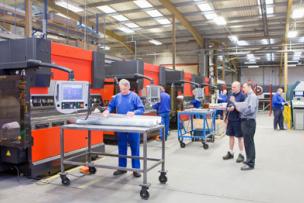As a brand of Saint-Gobain, a world leader in sustainable habitat, Norton offers the widest portfolio of grinding, cutting, blending, finishing and polishing solutions for all markets, materials and applications with the most advanced and affordable technology. So, as your needs evolve, our access to the global expertise of Saint-Gobain becomes even more valuable to making a difference in your day-to-day needs. And, we don’t have to look far for more localized expertise with our largest research center located right nearby in Northboro, MA.
Modern abrasive grains and stronger bonding methods found in the latest non-woven abrasives enable shops to quickly achieve desired surface quality.
SURFACE CONDITIONING
When improving the finish of welded fabricated parts, or blending the forging lines of casted components, both of these processes almost always require multiple steps. First, it is important to identify the surface finish requirement. Some parts will only require a visual inspection, but because there is subjectivity in this type of inspection, it is best to perform finish inspections using a device called a profilometer.
A profilometer measures the depth of a scratch within the material. A higher Ra means there is a deeper scratch or worse finish. A lower Ra means a smaller scratch, and therefore a better finish. A welded component may have an Ra as high as 100, whereas a forged or molded part can be lower. But typically, most customers want an Ra somewhere in the range of 5 (almost mirror image) to about 20.
Improving the finish from 100 to 20 consists of using a finishing sequence of abrasive products starting with coarser (larger abrasive sizes) grit sizes and moving to finer (smaller abrasive sizes) grit sizes. The first abrasives application step is the most critical, as it will determine how much work is required to reach the required finish on a weld or when blending a mold line.
Historically, manufacturers have used a grinding wheel for this first step. In doing so, excessive scratches on the part may result, requiring additional steps to improve the finish. Having the skills and experience to apply the grinding wheel optimally, as well as selecting the best one for the application at hand, will certainly maximize results. However, using a grinding wheel that is too coarse when removing parting lines on castings, or during blending and finishing operations on welded products, can change the part geometry or size or result in having to scrap the workpiece for being out of dimensional tolerance. To reduce this risk, select a softer, finer wheel, such as the new Norton non-woven Vortex coarse grit wheel.







Talk to Us!
Leave a reply
Your email address will not be published. Required fields are marked *